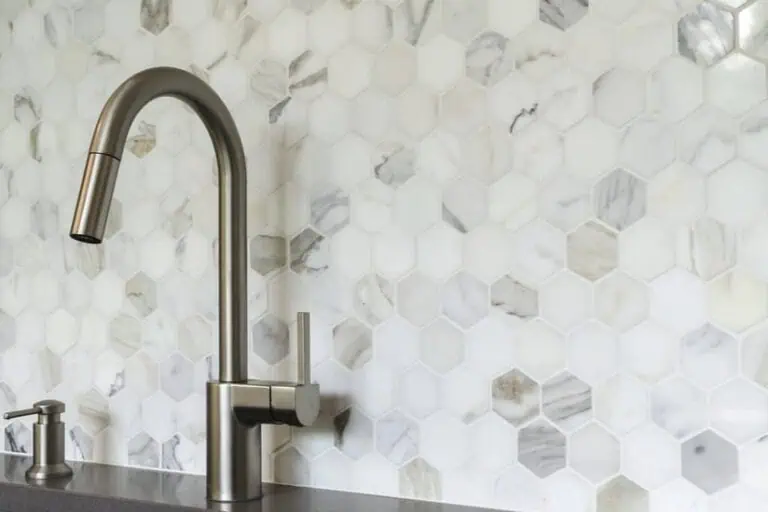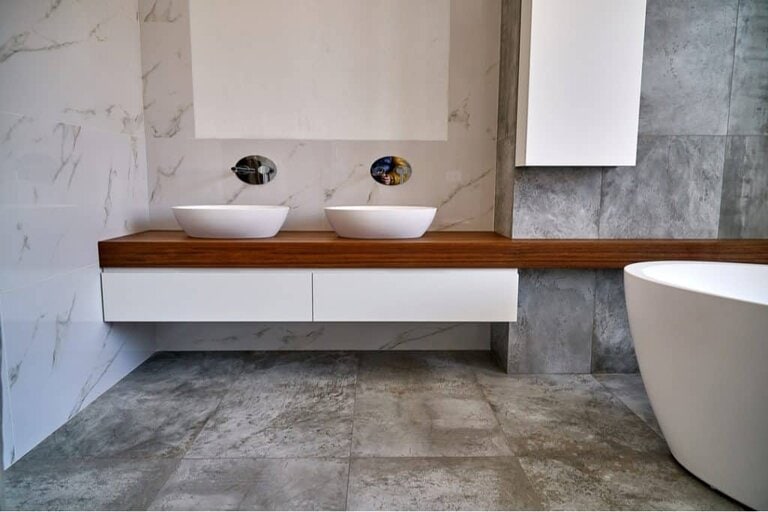The easiest methods to close the gap include adding a backsplash and using silicone caulk. We’ll discuss the best methods in detail below.
Why is it crucial to fill the gap between the bathroom vanity and wall?
Not only does this gap spoil the bathroom’s look, but it also provides a space for bacteria, mold, and mildew to grow. Also, it becomes difficult to clean the dirt and grime if the gap is too narrow. Therefore, it’s necessary to close the gap for enjoying a clean and polished bathroom.
Ideas for gap between bathroom vanity and back wall
#1 Use caulk (small gaps)

If the gap is small (less than half-inch), we can fill it with silicone or elastomeric caulk. Both silicone and elastomeric are water-resistant products, so there is no need to worry about water leaking through the caulk into the walls.
#2 Bathroom sealant tape (small gap)
Bathroom sealant tapes are waterproof and help deal with the small gaps between the bathroom vanity and wall. Plus, these tapes are long-lasting and take the least amount of time for installation. Once the tape wears off, it’s quick and easy to replace it with a new one. Here are two things to consider:
- Before applying the tape, make sure the area is completely clean and dry. If applied on a wet surface, it won’t stick properly.
- After applying the bathroom sealant tape, press it properly so that the glue sticks to the surface.
#3 Backer rod (medium gap)

A backer rod and caulk is another simple way to close medium-sized gaps. Place the backer rod to fill the gap and seal the rod using high-quality caulk for better support and security.
Use a caulk that matches the vanity and wall color to avoid an unpleasant look in the bathroom. If finding matching caulk is difficult, then clear-drying caulk will be the best option.
#4 Backsplash (larger gaps)

Backsplash, also known as drywall, is not only a convenient idea but can also be an interesting addition to the overall design. For example, adding a pop of color to the bathroom is easier with a backsplash. There are endless options available in the market for backsplashes, so it’s easy to choose any color and design as per the theme requirements.
Ideas to fill the gap between bathroom vanity and back wall
#1 Tile the sidewall

Sometimes we may notice that the vanity isn’t flush with the bathroom’s sidewall. This problem occurs if the wall is not properly leveled, but it can be fixed easily with wall tiles. Tiles work similar to the backsplash but are more appropriate for the sidewall.
#2 Use a vanity filler strip
Vanity filler strips are the best options to fill the gaps that are half an inch to several inches wide. These are generally made of vinyl, wood, or plastic materials and are quick to install.
#3 Add a shelf or a side cabinet

The choice between shelf or cabinet depends on the actual space that needs to be filled. For a budget-friendly solution, custom shelves are better than cabinets.
However, if the distance is too much and the cabinet can fit in there – go for it! It will help give the bathroom a streamlined look.
Frequently Asked Questions
Caulk or grout, what’s the best option to fill the gap between vanity countertop and tiles/backsplash?
Usually, caulk is used between the vanity countertop and tiles/backsplash. The Tile Council of America recommends an approximately 1/8 inches wide joint of caulk at the seam.
What causes gaps between bathroom vanity and wall?
There are several reasons for this gap, but wall leveling is the most common. Other reasons include issues with the vanity’s structure that pushes it away from the wall, measuring errors, selection of smaller vanity cabinets, or choice of sink installation procedures.
Which caulk is ideal for bathroom vanities?
The kind of caulk we can select completely depends on the vanity’s countertop material. Pure silicone caulk is best for the granite ones as it helps provide a fine finish. However, the laminate vanity countertops provide more flexibility for the caulk selection.
From silicone and latex to acrylic, any type of caulk can go with laminate vanity countertops to cover gaps. However, to avoid dampness and water damage issues, it’s suggested to opt for silicone caulk as it offers commendable water resistance.
How large of a gap can be filled with caulk?
Caulk can help fill a gap that’s half an inch or less in width. If there are tiles on the wall, then try to find the caulk that’s similar to the grout’s color. Use sanded caulk for the gap larger than 1/8 inch in width, but regular caulk if it is less than that.
Is it right to seal over the caulk?
Yes, we can caulk over the previous caulk, but it isn’t helpful. So instead, it’s suggested to remove the older caulk first, clean the surface, and apply the new one for better strength.